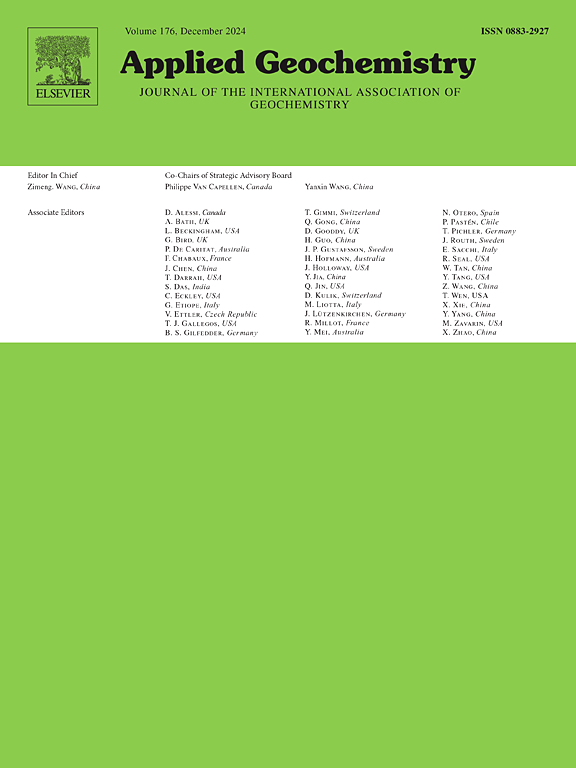Geochemistry and mineralogy of the late Neogene alkaline megalake sediments in the Qaidam Basin (China): Implications for provenance, tectonics, paleoclimate, paleoenvironment and organic matter accumulation
IF 3.1
3区 地球科学
Q1 GEOCHEMISTRY & GEOPHYSICS
引用次数: 0
Abstract
The late Neogene is widely regarded as a suitable analogy for future climate scenarios, but the paleoclimatic conditions of this period on the Qinghai-Tibet Plateau remain poorly understood. This study investigates the mineralogical composition and elemental geochemistry of 24 shale samples from two wells in the Yiliping Depression of the Qaidam Basin to reconstruct the paleodepositional conditions of the sediments and the late Neogene paleoclimate conditions. The results indicate that the chemical composition of the late Neogene alkaline lacustrine sediments was little affected by sediment recycling, sorting, diagenesis and metasomatism. Provenance analysis indicates a predominantly felsic source with minor contributions from intermediate volcanic rocks, formed under a tectonic setting similar to continental island arc tectonic settings in geochemistry. Paleoclimate reconstructions reveal consistently arid and cold conditions on the Qinghai-Tibet Plateau, characterized by weak chemical weathering. These climatic conditions were colder than those achieved in most contemporaneous regions globally, with a distinct cooling trend from the late Neogene to the Pleistocene. The deposition occurred predominantly in hypersaline environments, with localized transitions to brackish conditions. The redox conditions of the water column varied spatially, i.e., oxic waters dominated in the central depression (the H 1 well area), while the margins of the depression (the Y 3 well area) experienced fluctuations between oxic to anoxic conditions. The primary paleoproductivity in the Y 3 well exhibited similarities to that in the Holocene lakes of Peru and Brazil, whereas the H 1 well showed resemblances to most marine sediments. Notably, the primary paleoproductivity of the studied samples was lower than that of typical upwelling systems. Organic matter preservation was principally controlled by depositional conditions, with little effects from primary paleoproductivity and sedimentation rate/detrital input. This work provides valuable insights into the late Neogene climate dynamics on the Qinghai-Tibet Plateau and enhances the understanding of the formation of microbial gas source rocks.
柴达木盆地晚新近纪碱性巨湖沉积地球化学与矿物学:物源、构造、古气候、古环境和有机质聚集意义
新近纪晚期被广泛认为是未来气候情景的合适类比,但青藏高原这一时期的古气候条件仍然知之甚少。对柴达木盆地一里坪凹陷2口井24份页岩样品进行了矿物组成和元素地球化学研究,重建了沉积物的古沉积条件和晚新近纪的古气候条件。结果表明,晚新近纪碱性湖相沉积物的化学成分受沉积物再循环、分选、成岩作用和交代作用的影响较小。物源区以长英质烃源岩为主,中间火山岩贡献较小,形成于地球化学上与大陆岛弧构造环境相似的构造环境下。古气候重建显示青藏高原持续干旱和寒冷,具有弱化学风化的特征。这些气候条件比全球大多数同时期地区的气候条件更冷,从晚新近纪到更新世有明显的降温趋势。沉积主要发生在高盐环境中,局部过渡到微咸环境。水柱氧化还原条件在空间上存在差异,即坳陷中心(h1井区)以含氧水为主,而坳陷边缘(y3井区)则在缺氧和缺氧状态之间波动。y3井的原始古生产力与秘鲁和巴西全新世湖泊的原始古生产力相似,而h1井的原始古生产力与大多数海相沉积物相似。值得注意的是,研究样品的初级古生产力低于典型的上升流系统。有机质保存主要受沉积条件控制,原生古生产力和沉积速率/碎屑输入的影响较小。这项工作为青藏高原晚新近纪气候动力学提供了有价值的认识,并加强了对微生物气源岩形成的认识。
本文章由计算机程序翻译,如有差异,请以英文原文为准。
求助全文
约1分钟内获得全文
求助全文
来源期刊

Applied Geochemistry
地学-地球化学与地球物理
CiteScore
6.10
自引率
8.80%
发文量
272
审稿时长
65 days
期刊介绍:
Applied Geochemistry is an international journal devoted to publication of original research papers, rapid research communications and selected review papers in geochemistry and urban geochemistry which have some practical application to an aspect of human endeavour, such as the preservation of the environment, health, waste disposal and the search for resources. Papers on applications of inorganic, organic and isotope geochemistry and geochemical processes are therefore welcome provided they meet the main criterion. Spatial and temporal monitoring case studies are only of interest to our international readership if they present new ideas of broad application.
Topics covered include: (1) Environmental geochemistry (including natural and anthropogenic aspects, and protection and remediation strategies); (2) Hydrogeochemistry (surface and groundwater); (3) Medical (urban) geochemistry; (4) The search for energy resources (in particular unconventional oil and gas or emerging metal resources); (5) Energy exploitation (in particular geothermal energy and CCS); (6) Upgrading of energy and mineral resources where there is a direct geochemical application; and (7) Waste disposal, including nuclear waste disposal.
 求助内容:
求助内容: 应助结果提醒方式:
应助结果提醒方式:


